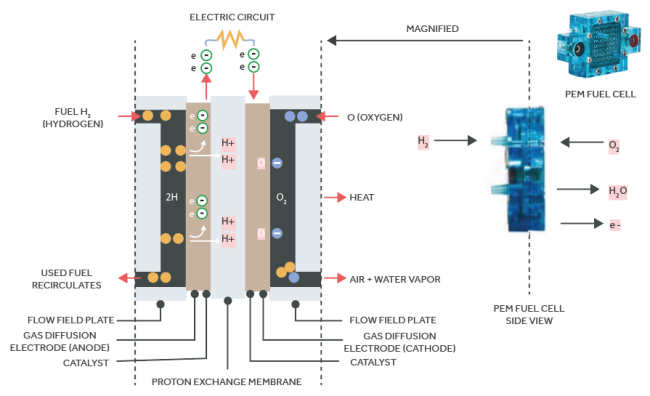Hydrogen Fuel Cells – How Do They Work?
In recent years hydrogen fuel cells have come to be used in a variety of industries, from planes, trains and trucking to more advanced industrial applications. For many, however, this technology remains shrouded in mystery. This lack of understanding can cause problems in uptake, leading to reduced use of renewable energy.
Perhaps, then, it is worth going over the basics of this simple but potentially world-saving technology. So, let’s start at the beginning: what’s a fuel cell?
A fuel cell is, at its most basic, a component on an electrical circuit that uses a chemical reaction to produce electricity. Unlike a battery, it doesn’t need to be replaced – it receives all the energy it needs to run from outside its chemical reaction.
The chemical reactions that take place inside the fuel cell are, to put it mildly, quite impressive. First, there is a fuel – usually hydrogen fuel – whose chemical elements (hydrogen [H2] and oxygen [O2]) have reactants (the substances whose electrons will produce a current in the circuit). These reactants interact with the two electrodes of the fuel cell and are pumped in and out of a circuit. One of these electrodes is positively charged, and the other is negatively charged. In the case of a hydrogen fuel cell, hydrogen enters the positive electrode – which attracts hydrogen’s electrons and repels its protons. The complete opposite happens to oxygen, which runs into the negatively charged electrode, and this electrode repels oxygen’s electrons and attracts its protons. The repelled electrons are then pulled through the circuit towards the positively charged electrode. This movement of electrons – from the negatively charged electrode to the positively charged electrode – makes up the circuit’s electrical current.
The by-product of this reaction involving hydrogen (H2) and oxygen (O2) is water (H2O). This is the magic behind hydrogen energy production – the only chemical by-product of a hydrogen fuel cell is water. While fossil fuels may produce carbon dioxide or methane (and lead to climate change), hydrogen fuel cells create electricity without any fossil fuels being emitted.

And while hydrogen fuel cells – along with the entire renewable energy industry – have grown in size and importance, these basic chemical processes continue to be at the heart of every fuel cell.
In order to train the next generation of engineers capable of producing even more advanced fuel cells, schools will have to go beyond traditional STEM education. Using a STEAM approach – integrating art, design, critical thinking and creativity along with traditional STEM education – will better prepare future engineers to innovate and drive forward the renewable energy economy.

